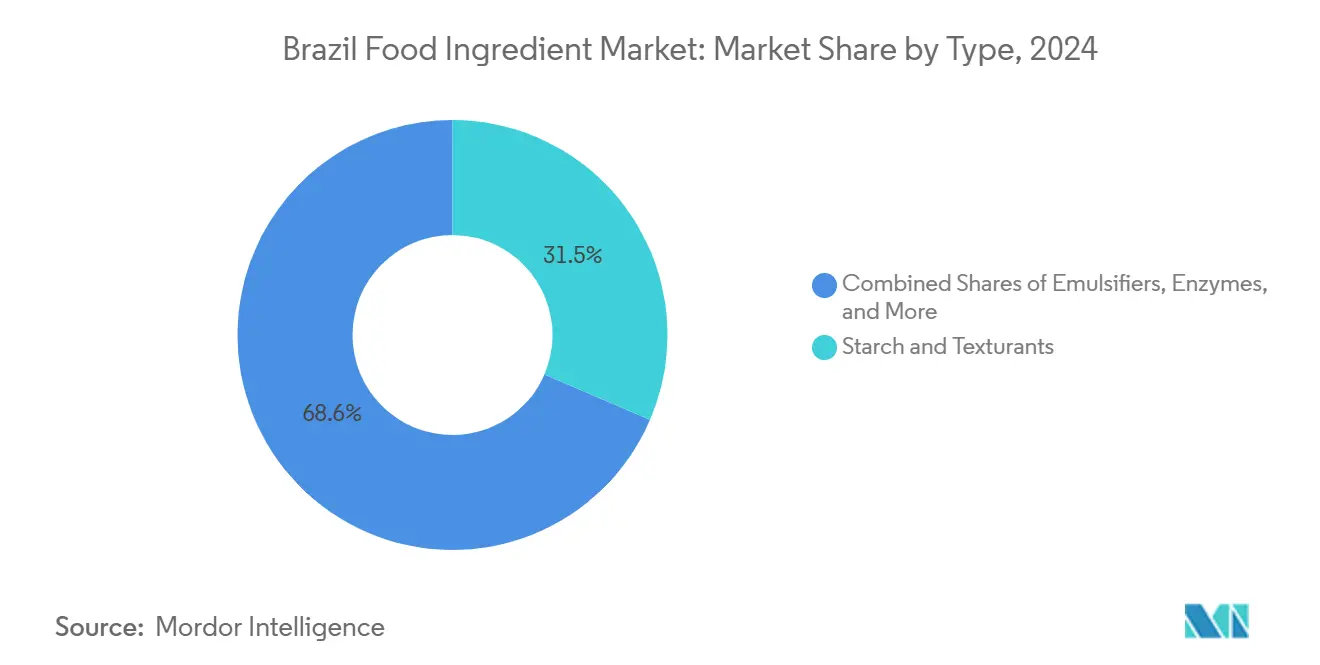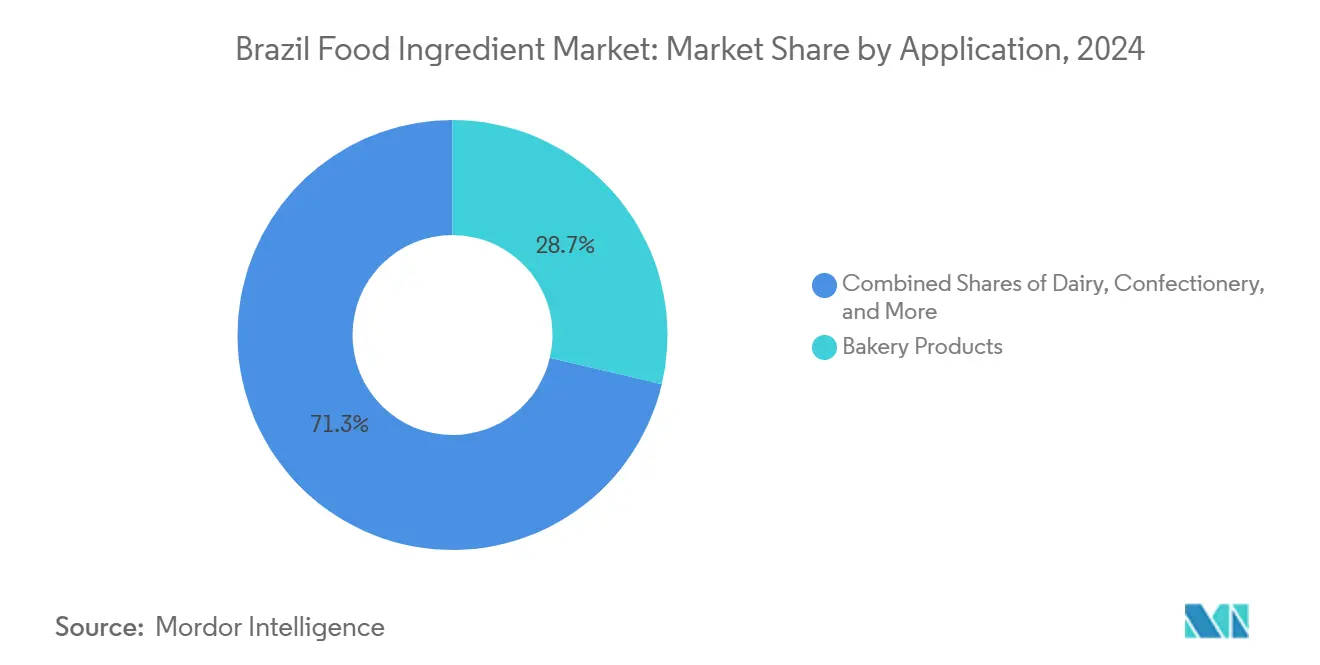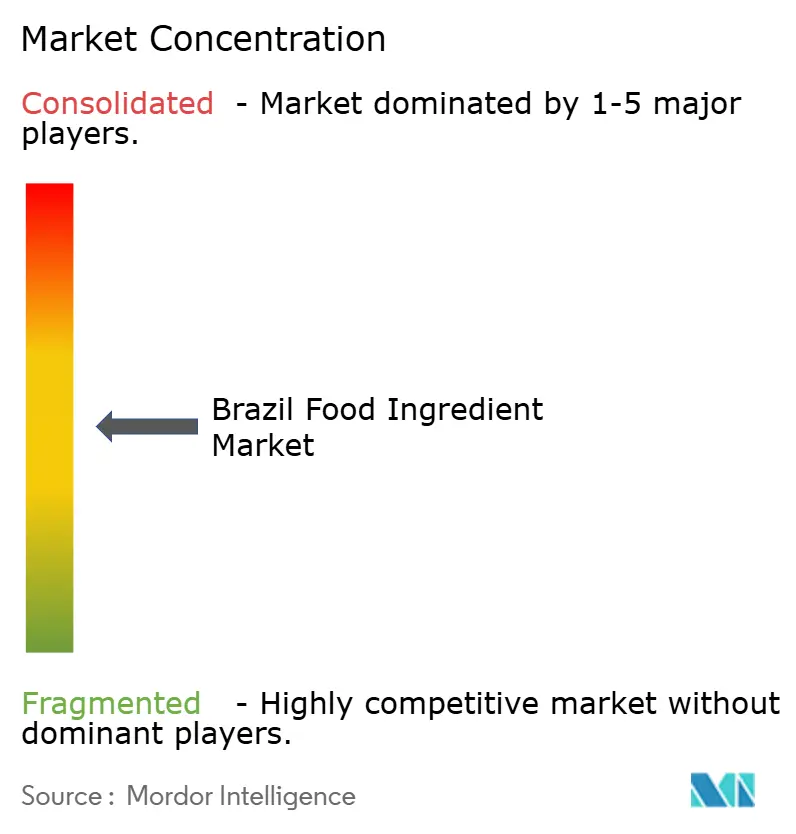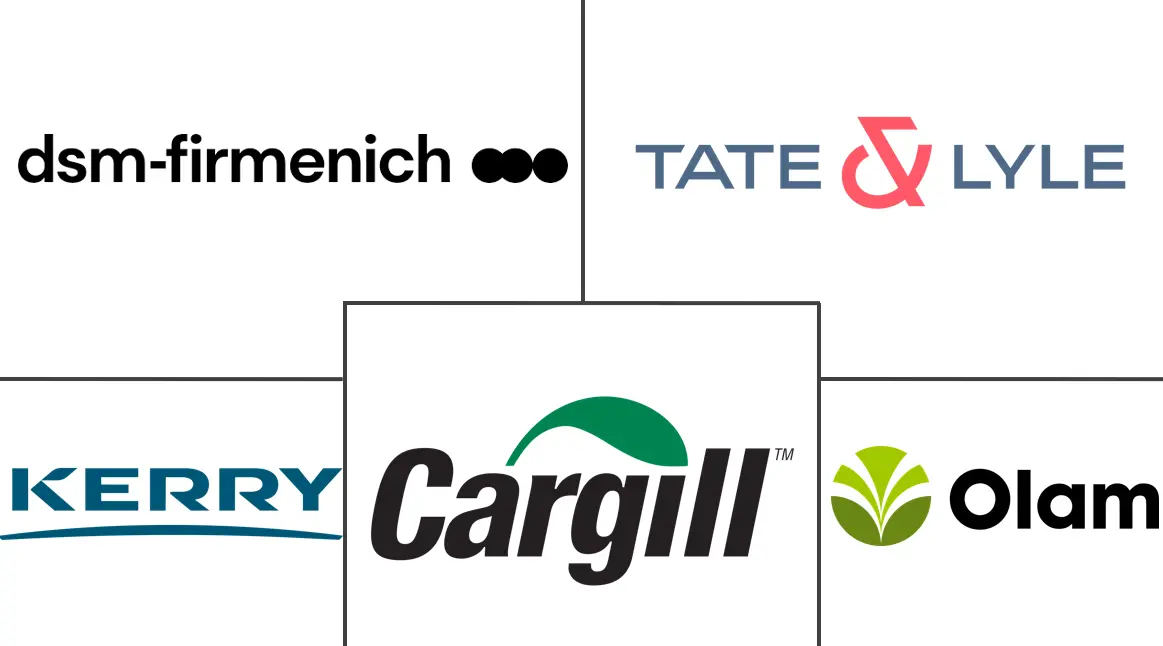
Brazil Food Ingredient Market Analysis by Mordor Intelligence
The Brazilian food ingredients market size reached USD 5.97 billion in 2025 and is forecast to expand to USD 7.40 billion by 2030, registering a 4.04% CAGR over the period. Domestic growth stems from a robust processed-food manufacturing base, rising health consciousness, and steady urbanization, while exports gain from Brazil’s status as the world’s largest supplier of processed foods by volume. Government-backed investments of USD 22.43 billion for 2023-2026 in plant modernization and capacity expansion keep capital flowing into ingredient demand hubs. Producers leverage Brazil’s deep agricultural raw-material pool to shorten supply chains and hedge price swings, yet downstream companies still navigate currency depreciation and climate-driven harvest volatility. Regulatory updates by ANVISA heighten compliance costs but also stimulate demand for reformulation services and specialty ingredients tailored to new nutrient and packaging rules. Mergers—such as Lesaffre’s majority acquisition of Biorigin and Prinova’s purchase of FlavorTec—signal that technology access and local operating footprints are decisive competitive levers in the Brazilian food ingredients market.
Key Report Takeaways
- By Type, Starch and Texturants led with 31.45% of the Brazilian food ingredients market share in 2024; Enzymes are projected to expand at a 5.48% CAGR through 2030.
- By Application, Bakery products accounted for 28.67% of the Brazilian food ingredients market share in 2024; Sweet and Savory Snacks are advancing at a 5.41% CAGR through 2030.
Brazil Food Ingredient Market Trends and Insights
Drivers Impact Analysis
| Drivers | (~) % Impact on CAGR Forecasts | Geographic Relevance | Impact Timeline |
|---|---|---|---|
| Rising Health and Wellness Consciousness | +0.8% | Global, with strong urban penetration in Southeast Brazil | Medium term (2-4 years) |
| Rising demand for natural and clean-label ingredients | +0.7% | National, with premium positioning in São Paulo, Rio de Janeiro | Short term (≤ 2 years) |
| Expansion of Brazil's processed food and beverage manufacturing | +1.2% | National, concentrated in Southeast and South regions | Long term (≥ 4 years) |
| Growing interest in vegan and cruelty-free ingredients | +0.5% | Urban centers, São Paulo, Rio de Janeiro, Brasília | Medium term (2-4 years) |
| Surge in launches of fortified and functional products | +0.6% | National, with regulatory influence from ANVISA | Short term (≤ 2 years) |
| Technological Advancements in food Processing | +0.9% | Industrial hubs in São Paulo, Paraná, Rio Grande do Sul | Long term (≥ 4 years) |
| Source: Mordor Intelligence | |||
Rising Health and Wellness Consciousness
Brazilian consumers increasingly prioritize health attributes in food choices, with 65% consuming plant-based alternatives at least weekly, according to GFI Brasil surveys, Confederação da Agricultura e Pecuária do Brasil[1]Source: Confederação da Agricultura e Pecuária do Brasil, “Indústria à base de plantas entra no radar do agro,” cnabrasil.org.br. This shift drives demand for functional ingredients, protein alternatives, and natural sweeteners, particularly in urban markets where disposable income supports premium positioning. Nestlé's expansion of fortified products like Nutren Fortify and Ascenda demonstrates the manufacturer's response to this trend, incorporating omega-3, vitamins, and mineral complexes to address specific nutritional needs. The trend accelerates as Brazil's aging population and rising healthcare costs motivate preventive nutrition approaches, creating sustained demand for bioactive compounds and nutraceutical ingredients.
Rising Demand for Natural and Clean-Label Ingredients
As Brazilian consumers increasingly scrutinize ingredient lists, clean-label formulations are gaining traction. These consumers are actively seeking products devoid of artificial additives, preservatives, and synthetic chemicals. This movement is especially pronounced in the bakery and confectionery sectors. Here, manufacturers are reformulating their offerings, turning to natural colors, plant-based emulsifiers, and botanical extracts. Research from Brazilian institutions highlights a rising trend: the adoption of anthocyanins, carotenoids, and betalains as natural colorants. However, these come with stability challenges, necessitating the use of encapsulation technologies and co-pigmentation strategies. While some clean-label practices, like plant-derived nitrite alternatives for cured meats, face regulatory gaps, it's noteworthy that ANVISA's evaluation is still pending. This is in stark contrast to their successful implementation in North American markets.
Expansion of Brazil's Processed Food and Beverage Manufacturing
Brazil's food processing sector, a significant contributor to the nation's economy, accounts for 10.8% of the GDP and employs over 1.6 million individuals across 36,100 companies, as reported by the United States Department of Agriculture's Foreign Agricultural Service[2]Source: Global Agricultural Information Network, “Brazil: Food Processing Ingredients Annual,” USDA, fas.usda.gov. Major players are making headlines: Nestlé is pouring R$1.1 billion into expanding its Caçapava site, which will soon house the world's largest KitKat production facility. Meanwhile, ADM is ramping up its premix capacity by 40% with a new nutrient factory in Paraná. Manufacturing activities are increasingly centered in the Southeast and South regions, strategically positioned near agricultural inputs and export infrastructure. The sector is also embracing digitalization, with Industry 4.0 at the forefront. A prime example is Heinz's corn processing plant in Goiás, which has integrated Rockwell Automation systems for comprehensive process control.
Technological Advancements in Food Processing
Brazil's food processing sector is undergoing a significant digital transformation, utilizing advanced technologies such as artificial intelligence (AI), Internet of Things (IoT) sensors, and predictive analytics to improve quality control processes and enhance operational efficiency. A notable example of this innovation is Tetra Pak's OneStep technology, which demonstrates its effectiveness by reducing operational costs by 20-40%, achieving 30% water savings, and increasing energy efficiency by 28%, with a particular focus on dairy processing applications. Additionally, Brazilian researchers are making remarkable progress in enzyme applications, successfully converting soybean processing byproducts into lipolytic enzymes, which are then used to produce fatty acid concentrates. Embrapa, a leader in digital agriculture, is driving advancements by implementing blockchain-based traceability systems and precision farming tools. These initiatives not only improve the quality of raw materials but also enhance transparency across the supply chain, creating opportunities for positioning premium ingredients in the market.
Restraint Impact Analysis
| Restraints | ~)% Impact on CAGR Forecasts | Geographic Relevance | Impact Timeline |
|---|---|---|---|
| Volatility in prices and availability of key raw materials | -1.1% | National, with acute effects in Northern Brazil | Short term (≤ 2 years) |
| Complex ANVISA registration and customs procedures | -0.7% | National, affecting importers and new entrants | Medium term (2-4 years) |
| Infrastructure and logistics constraints | -0.9% | Northern Brazil, rural areas, port corridors | Long term (≥ 4 years) |
| Rising Health Concerns over the use of Artificial Ingredients | -0.5% | Urban centers, premium market segments | Medium term (2-4 years) |
| Source: Mordor Intelligence | |||
Volatility in Prices and Availability of Key Raw Materials
Severe droughts and floods in Rio Grande do Sul, combined with a 27% appreciation of the dollar, have significantly contributed to food inflation, which has reached 7.69% in 2024. This highlights the substantial impact of raw material price instability on ingredient costs, as reported by Brasil de Fato[3]Source: Brasil de Fato, “Seca, enchente e dólar: entenda as causas da alta dos alimentos,” brasildefato.com.br. Coffee prices have climbed to an unprecedented R$2,302 per 60-kg sack, marking a record high. Meanwhile, CEPEA reported a 5.6% decline in soybean production, reducing output to 153 million tons, despite an overall increase in global supply. The situation is further aggravated by extreme climate conditions and the depletion of public food stocks, which intensify supply volatility. Government coffee reserves, in particular, have remained near zero since 2019, as noted by Brasil de Fato. Additionally, transportation bottlenecks have emerged as a critical issue, with record harvest volumes overwhelming truck capacities and driving freight rates to historic peaks.
Complex ANVISA Registration and Customs Procedures
ANVISA, Brazil's health regulatory agency, is known for its stringent and often cumbersome registration processes. These processes, laden with intricate documentation requirements, pose significant barriers for food ingredients and additives seeking market access. Recent updates, notably IN No. 281/2024, have further intensified these challenges. This regulation mandates comprehensive dossiers, encompassing everything from analytical certificates to stability studies and safety justifications. Moreover, ANVISA's principle of positive legislation permits only expressly authorized practices, tightening the reins on market entry. Compounding these challenges, the agency frequently alters regulations, compelling companies to continuously adapt their compliance strategies. The import landscape is equally complex. Multiple agencies, including MAPA for animal-origin products and ANVISA for processed foods, play pivotal roles. Customs clearance, a critical juncture, demands not only precise NCM classification but also a mountain of documentation.
Segment Analysis
By Type: Enzymes Drive Innovation Despite Starch Dominance
Starch and Texturants command 31.45% market share in 2024, benefiting from Brazil's abundant corn and cassava production and widespread application across bakery, dairy, and processed food sectors. However, Enzymes emerge as the fastest-growing segment at 5.48% CAGR (2025-2030), driven by technological advances in food processing and sustainability initiatives. Brazilian research demonstrates innovative enzyme applications, including lipolytic enzyme production from soybean processing wastes and specialized meat processing enzymes developed by companies like Bionov.
Alternative Sweeteners gain momentum amid sugar price volatility and health consciousness trends, while Flavors benefit from Brazil's rich biodiversity and growing demand for natural taste solutions. Preservatives face headwinds from clean-label trends, though natural preservation systems using plant extracts show promise. Emulsifiers and Colors adapt to clean-label demands through plant-based alternatives, while Cultures expand with probiotic and fermentation applications. Oils and Fats leverage Brazil's oilseed production advantages, and Yeasts benefit from biotechnology advances in fermentation processes.

Note: Segment shares of all individual segments available upon report purchase
By Application: Snacks Acceleration Challenges Bakery Leadership
Bakery Products maintain the largest application share at 28.67% in 2024, supported by Brazil's strong bread consumption culture and industrial expansion projects like Gasparin Cereais' USD 7.53 million facility in Erechim Gasparin Cereais. The biscuits and bread sector projects 3.7% growth, driven by product innovation and export expansion. Sweet and Savory Snacks emerge as the fastest-growing application at 5.41% CAGR, reflecting urbanization trends and changing consumption patterns favoring convenience foods.
Peanut butter and nut spreads demonstrate this shift, with sales growing 21.5% versus 12.5% for traditional chocolate spreads, driven by health positioning and protein content appeal. Beverages benefit from functional drink trends and plant-based alternatives, while Dairy applications expand through investments like Piracanjuba's USD 93.95 million whey protein facility and Lactalis's USD 58.93 million Paraná expansion. Confectionery adapts to rising cocoa costs through reformulation strategies, while Sauces, Dressings, and Condiments capitalize on flavor diversification trends. Frozen/Chilled Processed Foods grow with cold chain improvements and urbanization.

Note: Segment shares of all individual segments available upon report purchase
Geography Analysis
Brazil's food ingredients market concentrates in the Southeast and South regions, leveraging proximity to agricultural production, processing infrastructure, and consumer markets. São Paulo state dominates with major facilities, including Nestlé's expanded Caçapava plant and numerous multinational ingredient suppliers establishing regional headquarters, as demonstrated by Primient's new São Paulo office serving as their Latin America hub. Paraná emerges as a key growth region, attracting significant investments, including Lactalis's USD 313 million expansion in Carambeí and Londrina, and ADM's new nutrient factory in Apucarana, boosting production capacity by 40% Agrofy News.
The state benefits from being Brazil's second-largest milk producer with 4 billion liters annually and a strong agricultural base supporting ingredient raw materials. Northern Brazil faces infrastructure constraints that limit ingredient market development, with transportation bottlenecks affecting agricultural bulk movement and inadequate river port infrastructure reducing efficiency. The region has the lowest paved road density at 2.7 km/Mkm² and requires an estimated USD14 billion federal investment to reach satisfactory infrastructure quality ALG Global.
However, the Amazon region offers opportunities for biodiversity-based ingredients, as demonstrated by Greentech Brasil's sustainable sourcing programs involving 200 local families and the extraction of cupuaçu, murumuru, and castanha-do-pará for cosmetic and food applications, Brazil Beauty News. Central-West regions benefit from agricultural production advantages but face logistics challenges moving products to processing centers and export ports, with supply chain complexities requiring sophisticated network design to optimize tax benefits across states
Competitive Landscape
Brazil's food ingredients market exhibits moderate concentration with balanced competition between multinational corporations and domestic suppliers, though foreign companies dominate high-technology segments, including transgenic seeds, patented agrochemicals, and specialized processing enzymes. Strategic consolidation is accelerating through targeted acquisitions, including Lesaffre's 70% acquisition of Biorigin to strengthen yeast-derivative offerings, Prinova's acquisition of citrus oil processor FlavorTec, and Innovad Group's purchase of Brazilian feed additive supplier Oligo Basics.
Market participants increasingly pursue vertical integration and sustainability positioning, with major processors like JBS and BRF expanding into ingredient co-products, including gelatin and collagen production, while implementing traceability systems and carbon-neutral product launches. Technology adoption creates competitive differentiation, with companies investing in automation, digitalization, and Industry 4.0 implementations to improve efficiency and quality control. Domestic players like Bionov leverage specialized enzyme applications for meat processing, while international entrants establish local operations to serve regional markets more effectively.
Regulatory compliance capabilities increasingly determine market access, with companies requiring sophisticated regulatory affairs expertise to navigate ANVISA requirements and capitalize on market opportunities. The competitive landscape benefits from Brazil's agricultural abundance and processing scale, though infrastructure constraints and complex tax structures create operational challenges that favor companies with local expertise and established distribution networks.
Brazil Food Ingredient Industry Leaders
-
Kerry Group
-
Cargill Inc.
-
Olam International
-
Tate & Lyle Plc
-
DSM- Firmenich
- *Disclaimer: Major Players sorted in no particular order

Recent Industry Developments
- August 2024: Duas Rodas launched a natural Yuzu flavor and showcased innovative solutions for beverages with zero added sugar at Softdrinks Tech 2024 in São Paulo in August. The Yuzu flavor, characterized by a refreshing, bold citrus mix of lemon, tangerine, and grapefruit, was featured in non-alcoholic beverage formulations, including carbonated teas and energy drinks.
- June 2024: Duas Rodas showcased 18 innovative product launches under its Specialitá and Selecta brands at Fispal Sorvetes 2024 in São Paulo. The launches focus on premium ice cream ingredient solutions featuring unique flavors and surprising inclusions to elevate consumer sensory experiences.
- November 2023: The Tropical Food Innovation Lab officially opened in Campinas, Brazil, as a pioneering public-private partnership among global companies Givaudan, Bühler, Cargill, the FoodTech Hub Latam, and the Food Technology Institute (ITAL). The 1,300 square meter facility is equipped with advanced pilot plant lines including wet and dry extrusion systems for plant-based proteins, application labs, analysis laboratories, and a demonstration kitchen designed for collaborative product development.
Brazil Food Ingredient Market Report Scope
Food ingredients are added to a variety of food products to perform various functions, such as improving the overall safety and effectiveness, maintaining the nutritional value of food products, and improving the taste, texture, and appearance of the final food product.
Brazil's food ingredients market is segmented by type and application. Based on type, the market is segmented into starch and sweetener, flavors and colorants, acidulants and emulsifiers, preservatives, enzymes, edible oil and fats, and other types. Based on application, the market is segmented into bakery products, beverages, meat, poultry, seafood, dairy products, confectionery, and other applications.
The market sizing has been done in value terms in USD for all the abovementioned segments.
| Starch and Texturants |
| Alternative Sweeteners |
| Flavors |
| Acidulants |
| Preservatives |
| Emulsifiers |
| Colors |
| Enzymes |
| Cultures |
| Oils and Fats |
| Yeasts |
| Other Ingredients |
| Beverages |
| Sauces, Dressings and Condiments |
| Bakery |
| Dairy |
| Confectionery |
| Dried Processed Foods |
| Frozen/Chilled Processed Foods |
| Sweet and Savory Snacks |
| Other Applications |
| Type | Starch and Texturants |
| Alternative Sweeteners | |
| Flavors | |
| Acidulants | |
| Preservatives | |
| Emulsifiers | |
| Colors | |
| Enzymes | |
| Cultures | |
| Oils and Fats | |
| Yeasts | |
| Other Ingredients | |
| Applications | Beverages |
| Sauces, Dressings and Condiments | |
| Bakery | |
| Dairy | |
| Confectionery | |
| Dried Processed Foods | |
| Frozen/Chilled Processed Foods | |
| Sweet and Savory Snacks | |
| Other Applications |
Key Questions Answered in the Report
Answer What is the current value of the Brazil food ingredients market?
The Brazil food ingredients market size stood at USD 5.97 billion in 2025.
How fast is demand for enzymes growing in Brazil?
Enzyme ingredients are projected to advance at a 5.48% CAGR through 2030, the fastest rate among type categories.
Which application segment is expanding the quickest?
Sweet and Savory Snacks are expected to post a 5.41% CAGR between 2025 and 2030 as urban consumers favor convenient protein-rich options.
How are raw-material price swings affecting ingredient suppliers?
Climate events, freight bottlenecks, and currency shifts have driven food inflation to 7.69%, prompting suppliers to renegotiate contracts and diversify sourcing to protect margins.
Page last updated on:



